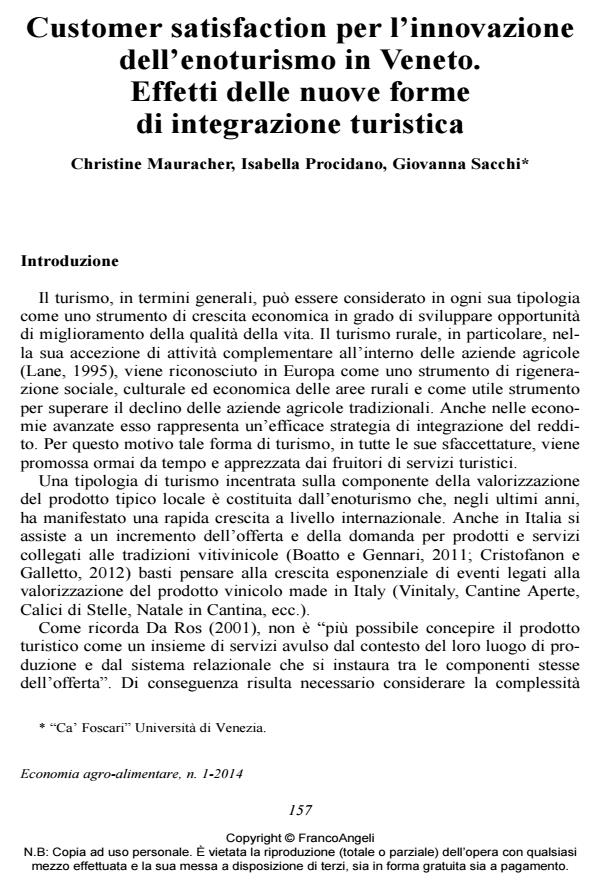Customer satisfaction per l’innovazione dell’enoturismo in Veneto. Effetti delle nuove forme di integrazione turistica
Titolo Rivista ECONOMIA AGRO-ALIMENTARE
Autori/Curatori Christine Mauracher, Isabella Procidano, Giovanna Sacchi
Anno di pubblicazione 2014 Fascicolo 2014/1
Lingua Italiano Numero pagine 22 P. 157-178 Dimensione file 255 KB
DOI 10.3280/ECAG2014-001008
Il DOI è il codice a barre della proprietà intellettuale: per saperne di più
clicca qui
Qui sotto puoi vedere in anteprima la prima pagina di questo articolo.
Se questo articolo ti interessa, lo puoi acquistare (e scaricare in formato pdf) seguendo le facili indicazioni per acquistare il download credit. Acquista Download Credits per scaricare questo Articolo in formato PDF

FrancoAngeli è membro della Publishers International Linking Association, Inc (PILA)associazione indipendente e non profit per facilitare (attraverso i servizi tecnologici implementati da CrossRef.org) l’accesso degli studiosi ai contenuti digitali nelle pubblicazioni professionali e scientifiche
In the last decades the phenomenon of wine tourism has shown a remarkable growth in several countries and continents of the world, from Australia through the United States to Europe, encouraging the interest of many scholars and producing a large volume of studies. According to the current debate, wine tourists expectations and preferences are likely to vary across regions as well as circumstances and it is not possible to identify a unique and stereotypical wine tourist, nor giving a unilateral definition of him or her behaviour (Charters and Ali-Knight, 2002; Bruwer et al., 2002; Alebaki and Iakovidou, 2010). If the attempt of identifying of a unique wine tourist is unrealistic, our contribution on wine tourism debate regards the proposal of a new line of research by analysing the customer satisfaction of wine tourists who chose to visit the production areas of Prosecco District in the Veneto Region. Therefore, our proposal joins the debate on wine tourism within two primary objectives: - to detect which are the determinants of wine tourism experience in the "Prosecco District"; and - to analyse the customer satisfaction level of wine tourists. The study explore the demand of wine tourists at different stage of their experience. In particular, the research is focused on identifying which are the preferences and needs of wine tourists that decide to visit Prosecco production territories, taste and buy local products. Furthermore, it is analysed tourists’ satisfaction with their experience to understand if some aspects or services should be innovated and/or improved. A web survey was administrated among wine tourists that subscribed to specific newsletters (i.e. Movimento del turismo del vino, Associazione Strada del Prosecco, wine companies newsletter etc.). There have been reached approximately 7.000 Italian and international tourists and wine tourist and there have been collected 400 questionnaires. The sample of people that already had an experience in the "Prosecco District" is composed by 200 people and they are compared to the remaining 200 individuals by the logistic regression (logit) model. This statistical model allows to understand which variables determine more than others a wine tourism experience in the considered area. In general terms, the results of the logit show that having more than 60 years, having planned another wine tourism experience, consuming often Prosecco and being a foreign tourist are the determinants of visiting the Prosecco District. The study give a complete picture of wine tourists’ motivating factors, characteristic and satisfaction of the sample in order to have a broader snapshot of the current situation in the considered area. Our findings will increase from one hand the level of knowledge of tourists’ preferences and, from the other, they will help in matching tourists’ expectations and needs. Having a broad and complete picture of wine tourists’ motivating factors, characteristic and satisfaction, indeed, will allow firms to position adequately into the market.
Parole chiave:Wine tourism determinants, customer satisfaction, Prosecco District (Italy), logit model
Jel codes:D12, C13, Q13
- Wine tourism quality perception and customer satisfaction reliability: the Italian Prosecco District Christine Mauracher, Isabella Procidano, Giovanna Sacchi, in Journal of Wine Research /2016 pp.284
DOI: 10.1080/09571264.2016.1211514
Christine Mauracher, Isabella Procidano, Giovanna Sacchi, Customer satisfaction per l’innovazione dell’enoturismo in Veneto. Effetti delle nuove forme di integrazione turistica in "ECONOMIA AGRO-ALIMENTARE" 1/2014, pp 157-178, DOI: 10.3280/ECAG2014-001008